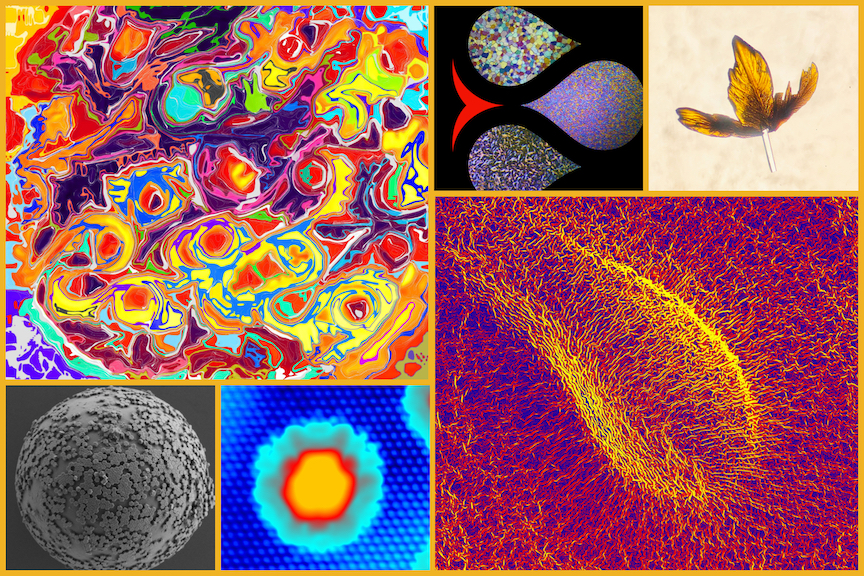
To celebrate National Nano Day, members of the Foundry community submitted 33 entries to our annual NanoArt Image Contest. National Nano Day is an annual celebration on 10/9 to help raise awareness of nanotechnology, how it is used in products that enrich our daily lives, and the challenges and opportunities it holds for the future.
After two rounds of voting, we have our winners! Gong Chen submitted the Foundry’s Choice – an image obtained from the Foundry’s SPLEEM (Spin Polarized Low Energy Electron Microscope) of a material used in magnetic memory and logic devices. Alexander Mueller’s image of a polymer electrolyte film which can be used to prepare lithium-metal batteries won the People’s Choice.
Rounding out the top 6 overall, an image submitted by Xiaoxi Wei of X-Therma won second place in both categories, depicting different forms of ice crystals. In third place in the People’s Choice round we have an image from Zhi Li of a perovskite material, and finally, Yawei Liu’s image of nanodisks on a nanoparticle won third place in the Foundry’s Choice round. Finally, in 4th place in the Foundry’s choice, Katherine Cochrane submitted an image of a single sulfur atom that has been replaced by a carbon atom.
The submissions were voted on by the Foundry Community to determine the Foundry’s Choice, and votes were solicited from Berkeley Lab and the general public by social media to determine the People’s Choice. The top 3 placements in each category will be professionally printed and displayed in the Molecular Foundry lobby. More about each entry appears below.
Foundry’s Choice – 1st Place
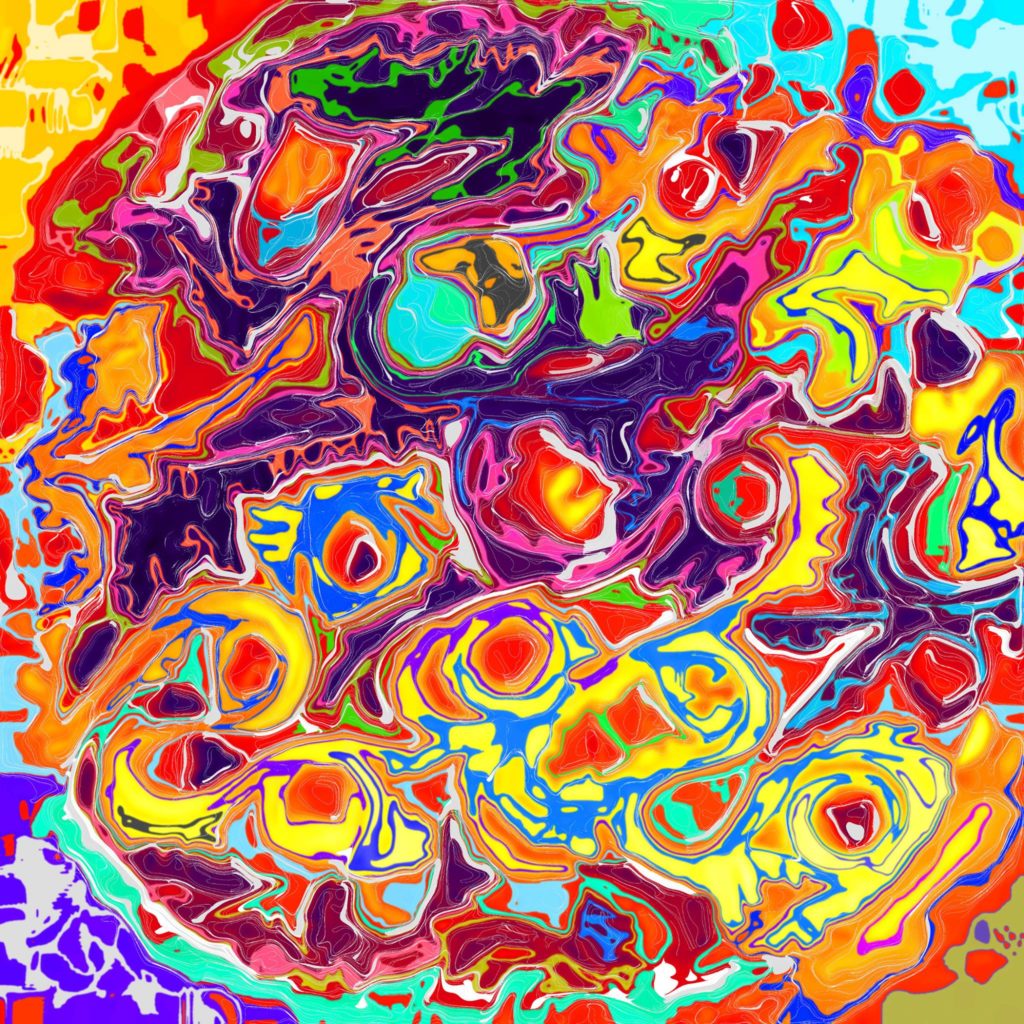
Submitted by Gong Chen, this Spin polarized LEEM image shows ultra-thin Cobalt islands on Ru(0001) crystal. The colorized areas highlight magnetic domain structures with various orientations. This material is used in magnetic memory/logic devices.
The image was taken on the SPLEEM at the National Center for Electron Microscopy by Gong Chen of UC Davis.
Foundry’s Choice – 2nd Place

Submitted by Xiaoxi Wei of X-Therma, Inc. Under polarized light, ice crystals reveals life saving secrets in a colorful wonderland. A story of “Nice Ice” enables life to thrive in a frozen world. (Top) water freezes into large hexagonal ice crystals; (Bottom) Antifreeze protein from arctic fish alters the ice crystals into dual pyramid shape. (Middle) Nature-inspired, Ice-interactive peptoid XT-ViVo shapes smaller, rounder and safer ice than Nature.
The XT-ViVo peptoid has been used to preserve murine hearts below 0C for greatly extended time periods and return back to life for successful transplants. Further application in human organ transplant will help end the organ transplant wait list and save millions of lives.
The image was taken at the Biological Nanostructures Facility on the Nikon Optiphot-POL polarized microscope w/ X-Therma Cryostage by Xiaoxi Wei, X-Therma Inc., including assistance by Mark Kline, Adam Childs, Mussie Gide, and Andrea Callegari.
Foundry’s Choice – 3rd Place
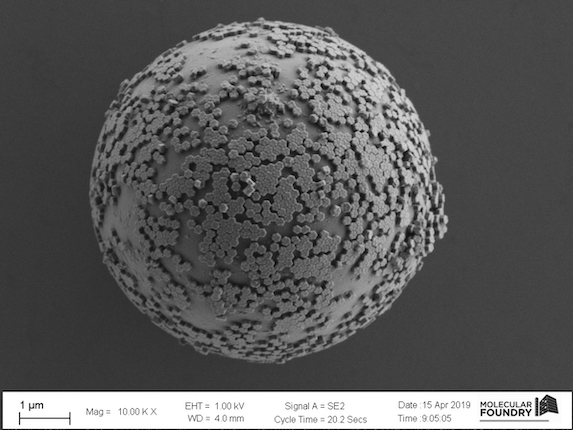
Submitted by Yawei Liu. Researchers used an improved method to coat a monolayer of upconverting nano-disks on the surface of BaTiO3 micro-cavities to generate high quality microlasers. The method they used can improve the quality of the micro-cavities, lower the lasing threshold, and results in sharper lasing peaks.
The material was created in the Inorganic Nanostructures facility and imaged on the ULTRA 55 – FESEM in the Imaging facility. The research team included Yawei Liu, Ayelet Teitelboim, and Emory M. Chan.
Foundry’s Choice – 4th Place

Submitted by Katherine Cochrane. This is a nanoscale image of tungsten disulfide showing the atomic scale electronic structure. A single sulfur atom has been replaced by a carbon atom and causing a dramatic change in the local electronic environment, resulting in this fiery cloud of electrons. Atomically thin WS2 has many different applications, from quantum information systems to flexible electronics.
The image was taken on the low temperature scanning tunneling microscope in the Imaging facility. The research team includes Katherine A. Cochrane, Bruno Schuler, and Alex Weber Bargioni.
People’s Choice – 1st Place
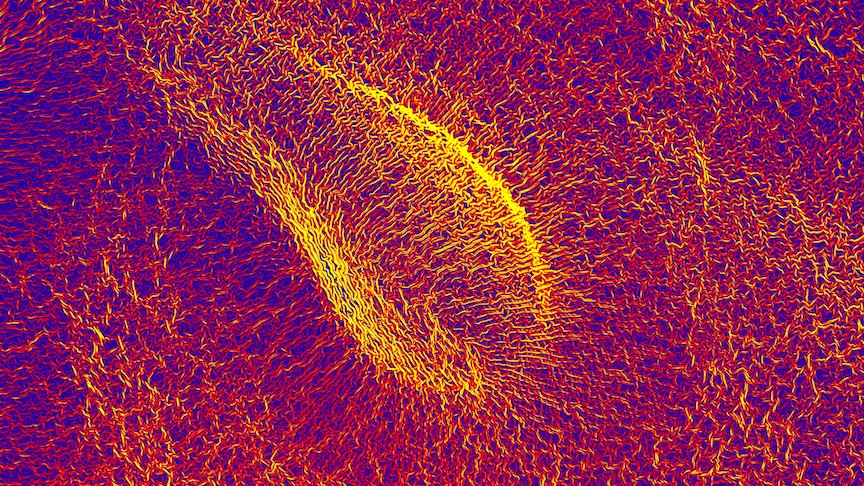
Submitted by Alexander Mueller. This image, which was acquired using an electron microscope, shows a polymer electrolyte film which can be used to prepare lithium-metal batteries. The polymer consists of two kinds of linked long-chained molecules which assemble into ordered, interpenetrating structures. The image was colored to accentuate the sample’s intricate morphology and a defect in the film which stems from the casting process.
Batteries incorporating a lithium metal electrode have a higher energy density than traditional lithium-ion batteries, but face great challenges that limit their lifetime and stability. A possible solution to many of these issues is the inclusion of a block copolymer electrolyte that can self-assemble on the nanoscale into ion-conducting regions and mechanically stable regions. We use scanning electron microscopes to study the nanoscale morphology of these electrolytes, which in turn helps us understand their performance in batteries.
The image was acquired at the National Center for Electron Microscopy using the through-lens detector of a FEI Helios G4 UX operated at an acceleration voltage of 2 kV. The sample was prepared by Jacqueline Maslyn from the group of Prof. Nitash Balsara and the micrograph was taken by Alexander Müller from the group of Prof. Andrew Minor.
People’s Choice – 2nd Place

Submitted by Xiaoxi Wei of X-Therma, Inc. Under polarized light, ice crystals reveals life saving secrets in a colorful wonderland. A story of “Nice Ice” enables life to thrive in a frozen world. (Top) water freezes into large hexagonal ice crystals; (Bottom) Antifreeze protein from arctic fish alters the ice crystals into dual pyramid shape. (Middle) Nature-inspired, Ice-interactive peptoid XT-ViVo shapes smaller, rounder and safer ice than Nature.
The XT-ViVo peptoid has been used to preserve murine hearts below 0C for greatly extended time periods and return back to life for successful transplants. Further application in human organ transplant will help end the organ transplant wait list and save millions of lives.
The image was taken at the Biological Nanostructures Facility on the Nikon Optiphot-POL polarized microscope w/ X-Therma Cryostage by Xiaoxi Wei, X-Therma Inc., including assistance by Mark Kline, Adam Childs, Mussie Gide, and Andrea Callegari.
People’s Choice – 3rd Place
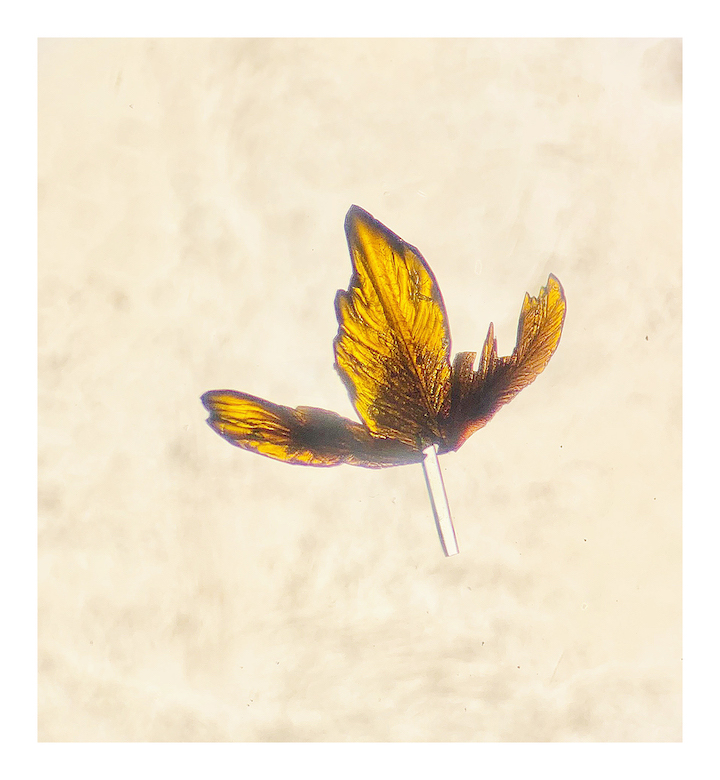
Submitted by Zhi Li. Turning over a new LEAF in perovskite research: the researchers developed a new robotic approach, RAPID (Robot-Accelerated Perovskite Investigation and Discovery), that accelerates the discovery of metal halide perovskite materials using inverse temperature crystallization and Anti-solvent Vapour-Assisted Crystallization methods. The image shows Butane-1,4-diammonium lead iodide crystals that could be used in photovoltaics, LEDs, and lasers.
The material was created in the Inorganic Nanostructures facility and the image obtained using an optical microscope. The research team includes Mansoor Ani Najeeb, Zhi Li, Joshua Schrier, Alexander J. Norquist, and Emory M. Chan.
Honorable Mentions
There were so many excellent entries in this year’s competition! Below are images that received many votes, but not quite enough to win this year.
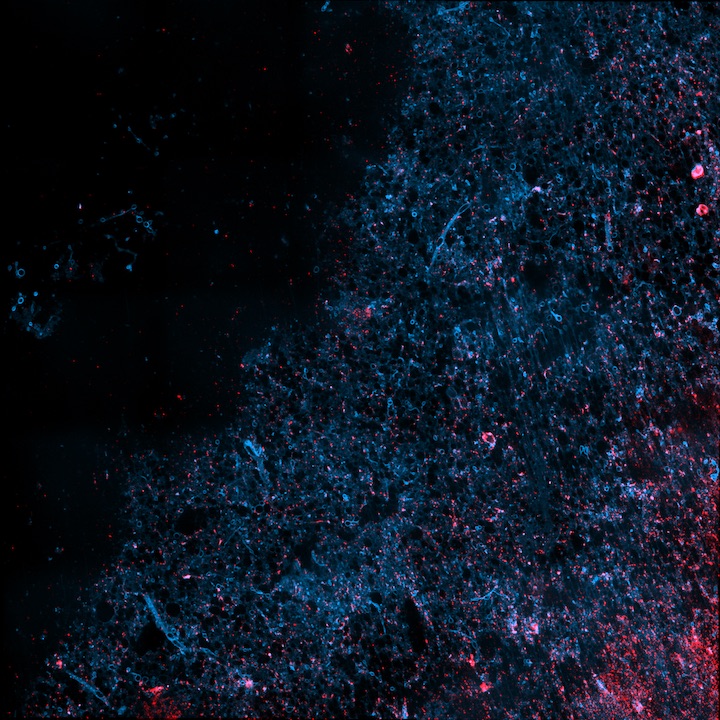
A submission by Bruce Cohen showing a live mouse brain slice labeled with quantum dots functionalized with a cocaine analog that binds to dopamine transporters. Quantum dots are red and neurons are lightly counter-stained blue. 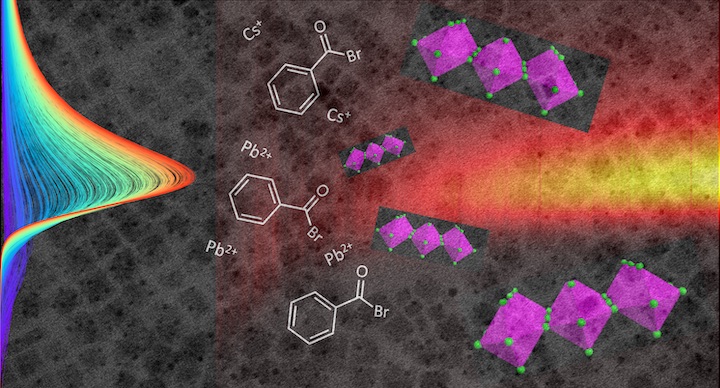
Submitted by Carolin Sutter-Fella. This illustration depicts in situ photoluminescence (PL) spectra used to monitor the growth of CsPbBr 3 perovskite nanoplatelets via colloidal synthesis. Lateral size, width and corresponding emission wavelength are finely tuned to obtain 2–6 unit cell thick nanoplatelets. 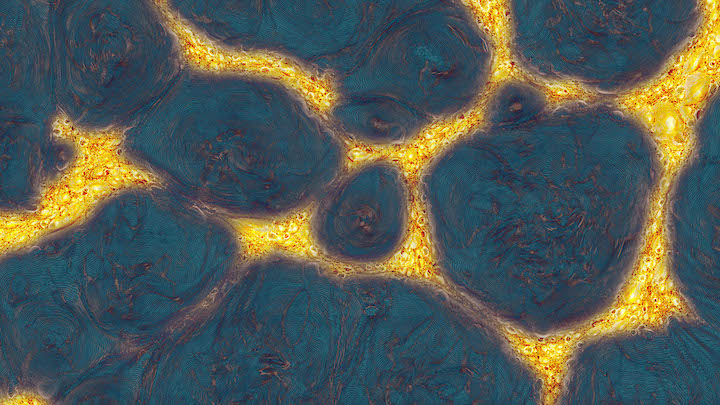
Submitted by Alexander Mueller, this image shows a polymer electrolyte film which can be used to prepare lithium-metal batteries. The polymer consists of two kinds of linked long-chained molecules which assemble into ordered, alternating lamellar structures. These in turn form large (blue) and small (yellow) grains. 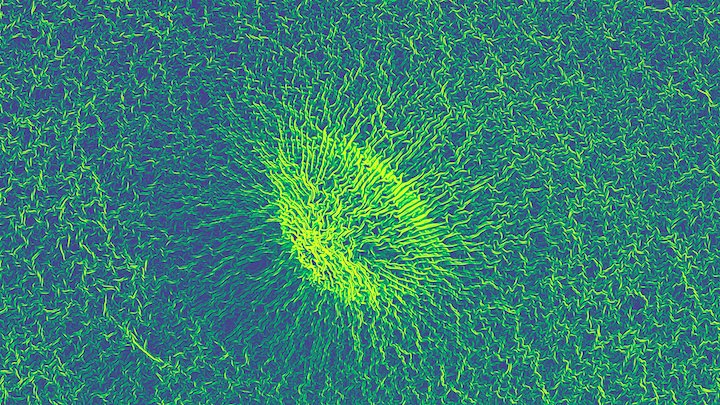
Submitted by Jacqueline Maslyn, this image shows a polymer electrolyte film which can be used to prepare lithium-metal batteries. The polymer consists of two kinds of linked long-chained molecules which assemble into ordered, interpenetrating structures. The image was colored to accentuate the sample’s intricate morphology and a defect in the film which stems from the casting process.

